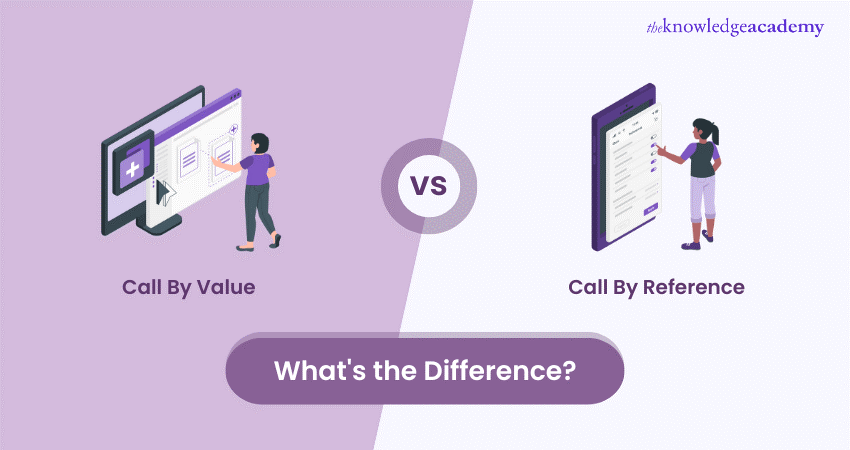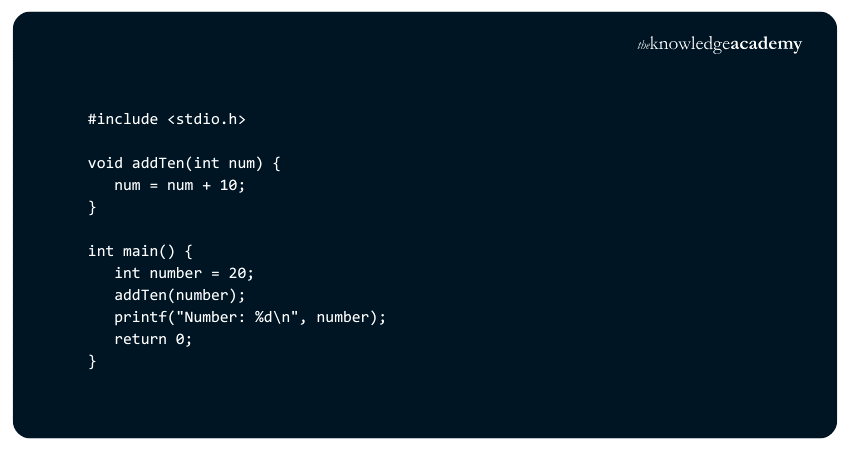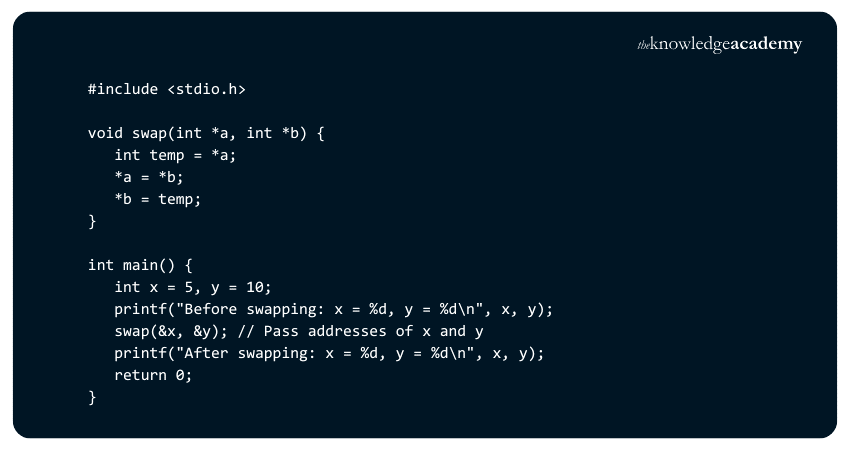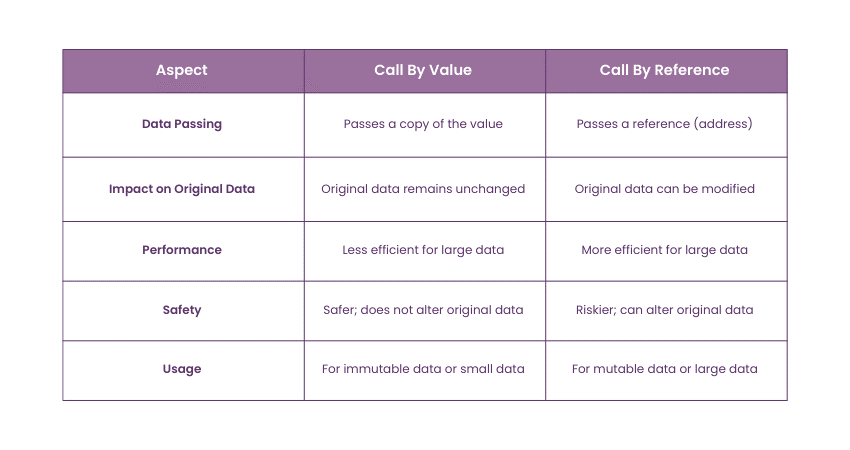We may not have the course you’re looking for. If you enquire or give us a call on +41 315281584 and speak to our training experts, we may still be able to help with your training requirements.
Training Outcomes Within Your Budget!
We ensure quality, budget-alignment, and timely delivery by our expert instructors.

Have you ever wondered how functions handle data in programming languages? When a function is called, does it work with the actual data or just a copy? The Difference Between Call By Value and Call By Reference lies at the heart of this question. Understanding these concepts is crucial for writing efficient and bug-free code.
In this blog, we'll dive deep into the Difference Between Call By Value and Call By Reference, exploring how they work, their effects on data, and when each method is most appropriate. By the end, you'll have a clear understanding of these fundamental concepts and be better equipped to make informed decisions in your coding projects.
Table of Contents
1) What is Call By Value?
a) How Does the Call By Value Method Work?
b) Examples of Call By Value
2) What is Call By Reference?
a) How Does the Call By Reference Method Work?
b) Examples of Call By Reference
3) Difference Between Call By Value and Call By Reference
4) Conclusion
What is Call By Value?
Call By Value is a method of passing arguments to a function where the function receives a copy of the argument’s value, not the actual variable itself. When a function is called, it gets its own local copy of the argument. This means any modifications made to the parameter inside the function only affect the copy, leaving the original argument unchanged.
Call By Value approach ensures that the original data remains intact, as the function works with a duplicate rather than the original variable. Call By Value is commonly used to prevent unintended side effects on the original data and maintain data integrity.
How Does the Call By Value Method Work?
This method involves passing the actual value to the function using the variable name directly. Here’s how it works:
1) Function Call: When we call a function, we include the actual parameter name in the function call syntax.
2) Value Copy: A copy of the actual argument’s value is created in the function’s memory space.
3) Local Operations: The function uses this copy to perform operations on the argument. Any changes made to the value are limited to this local copy.
4) Function Completion: Once the function finishes execution, the local copies of the function arguments are destroyed.
5) Original Value Unchanged: The original argument value remains unchanged in the memory space of the calling function.
Examples of Call By Value
Example in C:

Output:

Example in JavaScript:

Output:

In both examples, the original value remains unchanged, demonstrating that Call By Value does not modify the argument outside the function.
Start coding with JavaScript For Beginners Course and gain the skills to build interactive, modern web applications!
What is Call By Reference?
Call By Reference is a method of passing arguments to a function where a reference (or address) to the actual argument is provided rather than a copy of its value. This approach means that the function operates directly on the original data. As a result, any changes made to the parameter within the function directly affect the original argument.
Call By Reference allows functions to modify the original data and can be more efficient for large data structures, as it avoids creating copies. This ensures that the function's operations have a direct impact on the data used in the calling context.
How Does the Call By Reference Method Work?
Here's how the Call By Reference method works:
1) Create a Pointer: First, a pointer or reference variable is created to store the memory address of the actual argument.
2) Pass the Reference: This memory address is then passed to the function rather than the actual value. The function receives a pointer or reference to the original argument.
3) Access Data: Using the dereference operator (typically ‘*’ in many programming languages), the function can access and manipulate the data at the referenced memory location.
4) Modify Data: Any changes made through the pointer or reference directly affect the original argument in the calling function’s memory.
Examples of Call By Reference
Example in C:

Output:

Example in JavaScript:

Output:

Join our C Programming Course and transform your programming skills into professional-level expertise – register now!
Difference Between Call By Value and Call By Reference
Here’s a comparison to help clarify the distinctions between these approaches and their impact on performance, data integrity, and usage scenarios.

1) Data Passing:
a) Call By Value: When a function is called, a copy of the actual value is passed. This means the function operates on this copy, not the original data.
b) Call By Reference: Instead of passing a copy, a reference (or address) to the original data is passed. The function directly accesses and manipulates the original data.
2) Impact on Original Data:
a) Call By Value: Since the function works with a copy, any changes made within the function do not affect the original data outside the function.
b) Call By Reference: The function can alter the original data because it operates directly on it. Thus, modifications inside the function are reflected in the original data.
3) Performance:
a) Call By Value: This can be less efficient, especially with large data structures, because creating copies of large data can be resource-intensive.
b) Call By Reference: More efficient for large data structures, as it avoids the overhead of copying and instead just passes a reference to the existing data.
4) Safety:
a) Call By Value: Offers better data integrity and safety since the original data cannot be altered by the function. This reduces the risk of unintended side effects.
b) Call By Reference: Carries a higher risk as the function can change the original data. This can lead to unintended consequences or side effects if not managed carefully.
5) Usage:
a) Call By Value: Preferred when you want to ensure that the original data remains unchanged and where functions do not need to modify the data. It's commonly used with basic data types and smaller data structures.
b) Call By Reference: Suitable when functions need to modify the data or when working with large data structures where copying would be inefficient. It's used for complex data types like objects and arrays in languages that support references.
Discover the world of coding, learn essential skills, and become a proficient programmer with our Coding Training Course – Join now!
Conclusion
Mastering the Difference Between Call By Value and Call By Reference empowers you to write smarter, more efficient code. By choosing the right method, you’ll safeguard data integrity, boost performance, and steer clear of coding pitfalls, elevating your programming prowess to new heights. Ready to code with confidence? The choice is yours!
Join our Java Programming Course and take your coding abilities to the next level with real-world projects!
Frequently Asked Questions

In Call By Value, arguments are passed by copying the actual values into function parameters. Changes made within the function don’t affect the original variables outside the function.

JavaScript is primarily Call By Value. However, when passing objects or arrays, the reference to the object is passed by value, so changes to the object within the function will affect the original object.

The Knowledge Academy takes global learning to new heights, offering over 30,000 online courses across 490+ locations in 220 countries. This expansive reach ensures accessibility and convenience for learners worldwide.
Alongside our diverse Online Course Catalogue, encompassing 19 major categories, we go the extra mile by providing a plethora of free educational Online Resources like News updates, , videos, webinars, and interview questions. Tailoring learning experiences further, professionals can maximise value with customisable Course Bundles of TKA.

The Knowledge Academy’s Knowledge Pass, a prepaid voucher, adds another layer of flexibility, allowing course bookings over a 12-month period. Join us on a journey where education knows no bounds.

The Knowledge Academy offers various Programming Training, including Coding Training Course, Python Course, Python Django Training and PHP Course. These courses cater to different skill levels, providing comprehensive insights into C Developer Job Description.
Our Programming & DevOps Blogs cover a range of topics related to Programming, offering valuable resources, best practices, and industry insights. Whether you are a beginner or looking to advance your Programming skills, The Knowledge Academy's diverse courses and informative blogs have got you covered.
Upcoming Programming & DevOps Resources Batches & Dates
Date
 Coding Training Course
Coding Training Course
Fri 29th Nov 2024
Fri 14th Feb 2025
Fri 11th Apr 2025
Fri 13th Jun 2025
Fri 15th Aug 2025
Fri 10th Oct 2025
Fri 12th Dec 2025







 Top Rated Course
Top Rated Course



 If you wish to make any changes to your course, please
If you wish to make any changes to your course, please


